Fig. 3.
Individual promoter regions for the CAGE TSSs in skeletal muscle. A. Individual muscle promoter region around the CAGE TSS cluster was identified using overlapped ATAC-seq and DNase-seq data (MACS2 peaks) (example for a bidirectional promoter); additionally, the density of TFBSs was shown (see Additional file1: Fig. S3). B. Open chromatin probability distribution around the CAGE TSS (− 2000 to + 2000 bp) is similar to the density of transcription factor binding sites (TFBSs) (thick and dashed lines are median and interquartile range, respectively). C. Individual muscle promoters (86%) show greater expression level and density of TFBSs than a small fraction of pseudo-promoter—a region − 2000 to + 2000 bp from the CAGE TSS clusters without (> 2000 bp from the CAGE TSS cluster) open chromatin. Median, interquartile range, 1–99% range, and P value (Wilcoxon test) values are shown. D. The individual muscle promoter regions for all promoters and bidirectional promoters are shown (arranged, from bottom to top, according to increasing total length of the promoter; each bidirectional promoter is depicted twice in relation to each TSS). E. The use of individual promoter regions increases the number of predicted TFs associated with changes in gene expression at 1 h, 3 h, and 6 h after exercise, compared with the use of standard regions with a fixed length

